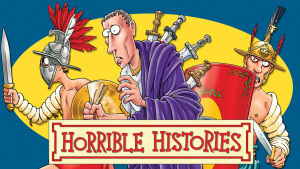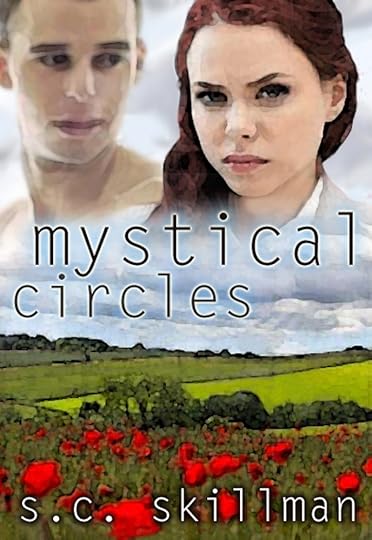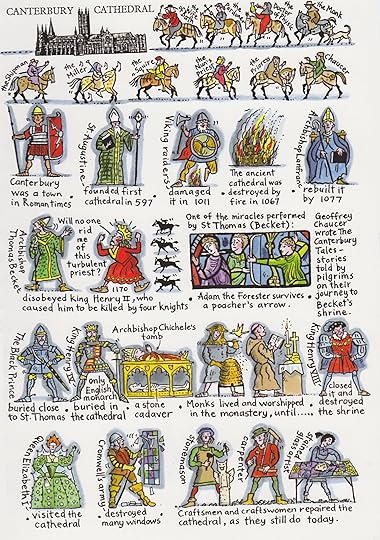S.C. Skillman's Blog, page 65
June 3, 2013
People of Inspiration Part 7: The Horrible Histories Cast
The Horrible Histories phenomenon will soon celebrate its 20th anniversary.
Scholastic will commemorate 20 years since Terry Deary published the first Horrible Histories books, Awesome Egyptians and Terrible Tudors.
Horrible Histories has continued through the British children’s television series, first screened on CBBC in 2009, and now in its 5th series.
In our house we have followed each series with ever-increasing hilarity and delight.
I love Rattus Rattus, “your host, the talking rat”; and I love every single member of the cast.
I think the pleasure lies in seeing a vast gallery of different historical characters from all social levels and periods and cultures, represented by the same small cast of recognizable, engaging actors.
Often when a team of people is involved in a creative project like this, fans will select a favourite.
And yet I cannot pick out any single one of this team as my favourite. Each of them is equally funny as a brutish thug, a tyrannical leader, a downtrodden peasant or an effete moony type circle dancing round a tree.

Jim Howick
There’s , who has on different occasions taken the parts of Napoleon, Blackbeard, Richard III, George IV, Pope Alexander VI, and Prince Albert.

Matt Baynton
There’s who is perfect as Mozart, Charles Darwin, Charles Dickens, Charles II, Shakespeare and Dick Turpin.

Simon Farnaby
There’s , hilarious in ”Stupid Deaths”, and entertaining as Caligula, St Augustine the first Archbishop of Canterbury, George III and numerous crazy or slightly dopey characters.

Laurence Rickard
There’s who does a perfect high-speed round-up of the religious scene in Tudor times, via HH TV News.

Ben Willbond
There’s whose Henry VIII is beguiling.

Martha Howe-Douglas
And there’s who is utterly convincing as Elizabeth I, Cleopatra, Queen Victoria, Joan of Arc, or any one of a number of women in history, whether they be aristocrats or underdogs.
So few actors and so many historical characters… they do the highest and the lowest in the land with equal skill. Posh and rough; they inhabit every character perfectly. And the songs are pure inspiration, written and composed by , a genius in the background.
Of course there are many others too who ensure this TV programme is such a success – and that so many of us love Horrible Histories.
Other posts you might like to check out in my “People of Inspiration” series:
Part 1 – Paul McCartney
Part 2 – Rabbi Lionel Blue
Part 3 – Susan Boyle
Part 4 – Rob Parsons
Part 5 – Frankie Howerd
Part 6 – Gareth Malone
Filed under: Books, British, history, inspiration, life, love, media, musings, people of inspiration, SC Skillman, SC Skillman Author, TV programmes, UK, Writing Tagged: actors, books, cast, CBBC TV series, delight, historical characters, HorribleHistories, HorribleHistories cast, love, phenomenon, SC Skillman author, TerryDeary, TV series


June 1, 2013
I’m on Instagram!
I have just joined Instagram: www.instagram.com/scskillman
I’ll be posting pictures relating to my books and anything else that takes my fancy.
I’ll also be posting individual character pictures, and pictures relating to the themes of Mystical Circles.
Many of the pictures and photos will be created by my talented media student daughter Abigail Robinson.
If you’re on Instagram I’d love it if you followed me!
Filed under: Art, British romantic suspense writer, life, literature, media, Mystical Circles, romantic suspense fiction, SC Skillman, SC Skillman Author, UK, Writing Tagged: characters, instagram, mystical circles, pictures, SC Skillman author, themes


May 20, 2013
The Great Gatsby – a Capacity for Hopefulness, Sparkling Decadence, and Tragedy That Touches Us All
The Great Gatsby, written in 1925, is one of the greatest American novels.

The Great Gatsby book
Yet its author, F.Scott Fitzgerald, died in 1940 believing himself a failure.
The Great Gatsby has been among my top favourites ever since I first read it, for my Contemporary American Literature course at university.
Two days ago I saw the latest movie of The Great Gatsby, and was reminded once again of how powerful this story is.
Back in my undergraduate days, such was the effect of this novel on me, that one evening in the bar, when asked what I’d like to drink, I requested mint julep.
My friend looked at me, and said reflectively, “they never even got round to drinking it, did they?”
And we both knew we were talking about that tragic scene in the Plaza Hotel, New York, in the later pages of Scott Fitzgerald’s novel.
I loved the new movie of the novel. Leonardo di Caprio and Toby Maguire were both excellent in the roles of Jay Gatsby and Nick Carroway.
And I asked myself yet again, Why does this novel touch me – and many others – so deeply?
For the answer to that, I must point you to one of the bloggers I follow. Zen and the Art of Tightrope Walking writes: “A good book should return you to your reality better able and prepared to cope with new challenges“.
When the movie ended an audible sigh arose in the cinema – the kind of sigh people give which means, I recognise this as truth, in my own life.
These were the words that gave rise to the sigh:
They were careless people…they smashed up things and creatures and then retreated back to their money or their vast carelessness or whatever it was that kept them together.
One of the most outstanding things about the book for me is the sheer poetic beauty in Scott Fitzgerald’s writing. Phrases from this book have stayed with me over the years, without any need to return to the book to check the quote:
Daisy and Gatsby looked at me remotely, possessed by intense life
and
Gatsby bought a mansion where he dispensed starlight to casual moths
and finally, the famous end to the novel:
so we beat on, boats against the current, borne back ceaselessly into the past.
Such is the symbolic power of the story, taking us from the immense wealth of a Long Island millionaire lifestyle into the industrial dumping ground of the Valley of Ashes,watched over by the huge eyes of a long-forgotten oculist, Dr TJ Eckleberg, that I believe The Great Gatsby is the kind of book we should be reading for our times, not pure escapism.
As my fellow blogger, Vivienne Tufnell, notes, there is a tendency for people to respond to life’s toughness by “turning more to entertainment that is pure escapism.”
I believe the exact opposite can be said of The Great Gatsby, and that is why this powerful story endures.
Read The Great Gatsby for a tragic contrast between careless hedonism and accumulation of vast wealth, versus harsh reality. But don’t read it for escapist romance.
Filed under: About Books I love, Authors I love, book reviews, Books, creative writing, inspiration, life, literature, love, media, movies, musings, SC Skillman, thoughts, Writing Tagged: capacity for hopefulness, carelessness, contemporary American literature, greatest American novels, hedonism, Long Island, millionaire lifestyle, money, New York, powerful story, ScottFitzgerald, sparkling decadence, The Great Gatsby book, The Great Gatsby movie, the valley of ashes, tragedy


May 6, 2013
Controlling Women in History and Life: Bess of Hardwick and Tudor England
Controlling women are a recurring theme in my life.

Bess of Hardwick First Lady of Chatsworth by Mary S Lovell
Add to this a love of history.
And so when I found the book Bess of Hardwick: First Lady of Chatsworth by Mary S. Lovell, I felt impelled to read it.
It is said that only when a lesson is learned, does an issue stop recurring in your life.
And so when I read of one of history’s most outstanding controlling women, I am filled with ambivalent feelings.
Three of the strongest, most fascinating women in history – some would call them controlling, others charismatic – all lived in the most turbulent of times, and intersected each others’ lives with the highest emotional stakes.
They were Mary Queen of Scots; Elizabeth I; and Bess of Hardwick.
When I recently visited Hardwick Hall and Chatsworth in Derbyshire, I knew little of Bess of Hardwick. Now, having just finished reading Bess of Hardwick: First Lady of Chatsworth by Mary S. Lovell, I am fascinated by her. And I cannot read of a powerful historical figure like this without drawing parallels and making connections with this life, and my own; and the world I know and move in.
If I was to sum Bess up for those who’ve never heard of her, I’d say she was a one woman estate and property corporation, plus social and dynastic engineer. She founded several of our great aristocratic families and greatest landowners. She was strong at a time when women were oppressed, manipulated and exploited.
She was a “Tudor entrepreneur”, absorbing knowledge from each of her four husbands, and applying it practically to far greater effect than they ever did.
I felt very sorry for her fourth husband the Earl of Shrewsbury. For he was caught up between these 3 strong women: Mary Queen of Scots, Elizabeth I & Bess of Hardwick. He ran up huge bills keeping Mary Queen of Scots captive; despite years of begging letters from him, Elizabeth I refused to pay him a penny for it; and the Earl likewise spent years refusing to pay Bess any of the allowances he’d agreed to give her before they married. And when his son broke into his bedchamber, following his death, he discovered there was indeed very little cash left in the Earl’s iron-bound coffers. In terms of liquid assets, the Earl had genuinely been run dry. No wonder the poor man ended up bitter, whining and querulous.
Early in her life, Bess was a feisty young woman who fought her corner shrewdly and relentlessly every step of the way, and made few mistakes.
Amongst her personal attributes, readers of this book will note perspicacity; vision; discernment; strategic planning; far-sightedness; a dignified and gracious bearing.
And all around her there swam those who were ruled by one or several of the following: greed, impatience, fecklessness, hot-headedness, lack of vision; lack of anger-management; lust; short-sightedness; tunnel vision.
I believe Bess succeeded because she was a wise and acute observer of human psychology, and applied it to the best practical effect throughout her life. What she did, she did with skill and balance. Where she took risks, she did so with psychology in mind. She was a master at networking, and choosing the right people to ask favours of, at the right time, in the right way.
We can all learn from her.
Bess of Hardwick: First Lady of Chatsworth reads like a morality tale about money, success and power.
Those who get it and keep it; those who get it and lose it; those who have a talent for letting it slip through their fingers; and the multifarious ways people with varying degrees of honour or dishonour behave around it.
Bess did make some mistakes – and one of these was her decision to hold captive her grand-daughter Arbella, who was in line to the throne, on an equal level with James I.
Bess was almost responsible for Arbella’s existence, having carefully engineered the coupling of Arbella’s parents for the very purpose of producing another heir to the throne.
But she imprisoned Arbella at Hardwick Hall, in almost the same manner as her 4th husband the Earl of Shrewsbury had tohold Mary Queen of Scots captive.
And not surprisingly, Arbella didn’t like it.
Things didn’t work out the way Bess hoped with Arbella – (which was that Arbella should become Queen of England after Elizabeth). If they had, it would have been Bess’s most triumphant achievement.
Instead Arbella’s fate was to make a forbidden marriage, to die a lonely, squalid death in the Tower, and to be written out of history.
Bess had plenty of bad luck and tragedy in her life but she always fought her corner and her personal strength brought her through.
This story reminds us, too, through the experiences of others in Bess’s social ambit, that in life there are those who do extremely well for many years, then make a massive error of judgement which ruins everything.
And there are others who spend years causing trouble and living fecklessly – who suddenly come upon a stroke of luck and find themselves in high favour.
But this can all be forfeited, once again, by poor judgement – or the intervention of fate.
All these elements of our own lives stand out in high relief against the political and social landscape of Tudor England – brutal punishment, hereditary succession, fortunes made and lost, sexual liaisons which threaten the throne, secret and fateful marriages and desperate bids for power.
If you love history, put this book on your list!
Filed under: About Books I love, Authors I love, book reviews, Books, British, buildings, empowerment, history, inspiration, interpersonal relationships, life, musings, people of inspiration, places I love, places of inspiration, psychology, SC Skillman, SC Skillman Author, thoughts, UK Tagged: Bess of Hardwick, Chatsworth, controlling women, fascinating women, Hardwick Hall, history, history and life, money, powerful women in history, SC Skillman author, this life, Tudor England


April 29, 2013
The Enduring Appeal of ‘A Kid With Spots’ in Fiction, TV, Movies & YouTube
There’s a character we love, in all forms of media.

Rory Barker, Researcher and Fall Guy on James May’s Man Lab
Is he the exciting hero? Is he clever, bold, handsome, courageous?
No. He’s a bit downbeat and low-key. A bit dumb. He drifts around in the background looking vacant.
And he’s the one we find most endearing.
He’s Rory Williams in Doctor Who Series 5-7.
He’s , who started as Junior Researcher in James May’s Man Lab.
We love them!
They’re in fiction too.
PG Wodehouse traded on them in his comic novels. Step forward Gussie Fink-Nottle. He’s Bertie Wooster’s friend, with a face like a fish. Gussie who’s ‘not quite with it’, he’s ‘caught up in his own world’ (which, in Gussie’s case, is an obsession with newts).
Sir Arthur Conan Doyle understood the archetypal power of this character too – in Dr John Watson, who seems dumb next to his brilliant colleage, Sherlock Holmes.
Among TV drama series we find Merlin. He plays this role for the benefit of Arthur, who doesn’t understand who Merlin truly is.
This character is ‘a bit of dill’, ‘a bit simple’.

Arthur Darvill as Rory Williams in Doctor Who
And YouTube high-flyers like Charlie McDonnell also understand the appeal of this character. He’s under-stated, he’s self-deprecating.
Among young adult novels, The Declaration Trilogy by Gemma Malley has a character called Jude, who entered in the second novel of the trilogy, and who very quickly became my favourite character.

Ben Wishaw as Q in Skyfall James Bond
And in films we find Q in Skyfall – ‘a kid with spots’, as OO7 points out when he first meets him in an art gallery.
‘My complexion is hardly relevant,’ he says to Bond.
These characters are anti-heroes who endear themselves to us. Another name for this character-type is “the ingenue”.
Long live the anti-heroes.
Our love for them tells us something very heartening about human nature.
Filed under: About Books I love, Authors I love, British, life, literature, love, media, movies, musings, SC Skillman, SC Skillman Author, thoughts, TV programmes, Writing Tagged: anti-hero, Conan Doyle, Dr John Watson, fiction, human nature, James May's Man Lab, love, Merlin, movies, PG Wodehouse, Rory Barker, Rory Williams, SC Skillman author, Sherlock Holmes, Skyfall, the ingenue, TV, YouTube


April 16, 2013
The Enduring Appeal of Action Hero TinTin and Why We Love Fresh-Faced Heroes and Their Adventure Stories
Last night I watched our DVD of “The Adventures of TinTin: the Secret of the Unicorn” again with my 15-year old son. And I knew afresh why I loved TinTin so much on TV during my teenage years.

The Adventures of TinTin movie poster
The Adventures of TinTin: The Secret of the Unicorn (directed by Peter Jackson & Steven Spielberg) was released in 2011. So it’s been out a while. But I write blog posts when something inspires or excites or moves me, and haunts me at night. And that’s what this TinTin story did.
I asked myself again, exactly what is the appeal of TinTin? He’s a totally beguiling hero. He’s Sherlock Holmes, James Bond and Spiderman all rolled into one fresh-faced boy hero – and of course his intrepid dog Snowy (originally named Milou by his creator, Herge).
As a child I loved adventure stories. I started with Enid Blyton and later I moved onto King Solomon’s Mines by Rider Haggard, and Prester John by John Buchan and Moby Dick by Herman Melville. These stories have everything – at their best they not only excite and thrill, but also they move, and they teach you about this life, and they convey archetypal truths about human nature.
You can draw parallels with your own life, even if you don’t do exactly the same dangerous things. You can use the action hero’s experiences as a metaphor to help you clarify what has happened to you, and what attitude to take. This is the power of a great story.
Take the archetypal villain, who pursues his obsession to its bitter end.
There are people who live their lives like this. They’re all around us. They express it in their relationships. People who have never learned the art of letting go.
Their obsession leads to such things as ‘unfinished business’ when family members die; ‘skeletons’ that stay in cupboards for generations; vendettas that last decades, family members who don’t talk to each other for years.
The lesson the archetypal villain and his fate teaches is this: ‘People matter more than things’.
In this life, what matters most of all, above ‘due recompense’, above ‘getting satisfaction’, above ‘being right’, is human relationships – and of course this is the lesson the archetypal villain never learns, and which the hero instinctively honours, or the story wouldn’t satisfy us.
TinTin is a hero who’s open to all that life has for him; he’s never held back by self-limiting beliefs; he’s ready to live on his wits, yet has an unerring instinct for a just cause, personified by a character who is flawed, but whose heart’s in the right place; then he throws in all his gifts on that character’s side.
Does this excite, inspire and move you, as it did me?
Filed under: About Books I love, Authors I love, Books, British, culture, inspiration, interpersonal relationships, life, literature, love, media, movies, musings, people of inspiration, SC Skillman, SC Skillman Author, thoughts, TV programmes, Writing Tagged: action hero TinTin, adventure stories, books, enduring appeal, fresh-faced heroes, heroes, in this life, love, movies, SC Skillman author, Secret of the Unicorn, the power of a great story, TinTin, villains


April 10, 2013
Mystical Circles Romance and Psychological Suspense Free Promotion Bonanza!

ad banner for Mystical Circles romantic suspense fiction
Mystical Circles is on free giveaway to Goodreads members for the next month!

Mystical Circles cover image – romance & psychological suspense in the heart of the English countryside – intense & compelling
Five copies of the paperback second edition are on offer.
Goodreads Members, get on over there and sign up for the giveaway!
Mystical Circles is also FREE ON KINDLE FOR 5 DAYS STARTING NOW!
ROMANCE AND PSYCHOLOGICAL SUSPENSE IN THE HEART OF THE ENGLISH COUNTRYSIDE – INTENSE & COMPELLING.
Add to your Goodreads shelf, download free on Kindle, or buy the paperback from the author!
Filed under: About Books I love, Authors I love, book reviews, Books, British, British romantic suspense writer, creative writing, interpersonal relationships, life, literature, love, Mystical Circles, places of inspiration, psychology, romantic suspense, romantic suspense fiction, SC Skillman, SC Skillman Author, spirituality, UK, Writing Tagged: contemporary, contemporary fiction, kindle, love, love story, mystery, mystical circles, relationships, romance, romantic suspense, romantic suspense free giveaway, romantic suspense free on Kindle, SC Skillman author, spirituality, suspense, women


April 8, 2013
The Curious Tale of a Rediscovered King, a DNA Trail and What It Tells Us of the Nature of Truth
“There were a lot of nasty rumours spread about me,” says Horrible Histories actor Jim Howick in his hilarious portrayal of King Richard III. “Tudor propaganda, it’s all absurd. Time to tell the truth about Richard III.”
Who was he? “That King they found in the car park in Leicester”. This will have been the phrase on many lips, of those who, with little historical knowledge, will nevertheless find this a topic of conversation with friends.

Richard III – earliest surviving portrait (credit : medievalhistories.com)
The story of Richard III to me illustrates how nothing in this life can guarantee any particular outcome. And as I read “the book that inspired the dig”: The Last Days of Richard III and the fate of his DNA by John Ashdown-Hill, this was brought vividly alive to me.
According to Ashdown-Hill, historian, genealogist, and member of the Richard III Society, Richard III was a young man probably too kind, too naive and too forgiving. If anything sewed the seeds of his downfall at the Battle of Bosworth in August 1485, it was that trust - for he was betrayed by the Stanley brothers, men he could easily have captured and imprisoned in the Tower much earlier, if he’d been sharper and more rutheless.
Because his death and defeat on that Bosworth Battlefield meant the end of one dynasty – the Plantaganets – and the beginning of another – the Tudors – a lot of hard work subsequently went into “re-writing history”: blackening his reputation, falsifying his story and character, and destroying historical evidence.
I cannot read of a historical figure like Richard III without seeing the parallels between his story and fate, and our own experience in this life.
For the basic principles of life do not change.
Nothing and no-one can guarantee any particular outcome for us. Not vice, not virtue. Not piety, not betrayal.
But of one thing I now feel assured by Ashdown-Hill’s book: where there is integrity and focused persistent research, and rigorous dedication, as in the painstaking work of the best historians and genealogists, truth, ultimately, will out.

Richard III facial reconstruction based upon his skull (credit: cnn.com)
Though it may be centuries later, and only after hundreds of years of fabrication and half truths and lies and myths.
On that day, 22 August 1485, at 8 am, Richard III rode onto the battlefield an anointed King, new marriage plans very much alive, expecting to reign for many more years. At 9.15am he was killed. And later, at 2 pm, he left the battlefield, a mud-and blood-spattered corpse, naked (stripped of his finery by the local scavengers who would have surrounded every medieval battlefield), slung over a horse, later to be tipped unceremoniously into a shallow grave in Leicester.
Only nine years later, in 1494, did his successor, Henry VII, cause a tomb to be erected over his grave at the Greyfriars church in Leicester – and then only because it served Henry’s own interests that it be publicly known that Richard III had been a true King, and not a usurper of the throne.
I can throroughly recommend Ashdown-Hill’s book; if you love history I believe you too will be fascinated by his methodology, as a historian and genealogist, as he teases out the trustworthy from the untrustworthy, the probable from the unlikely, evaluating the different grades and types of evidence and the quality of witnesses and testimonies against each other.
You too may find cause to reflect, as I have done, on the fact that tales about historical figures can often be total fabrication, or embroidered, or half- or quarter-truths, and only rigorous painstaking historical research can correct them.
Filed under: About Books I love, Authors I love, book reviews, Books, British, buildings, history, life, musings, people of inspiration, places of inspiration, religion, SC Skillman, SC Skillman Author, thoughts, UK, Writing Tagged: DNA, genealogist, historian, historical figure, Horrible Histories, in this life, Jim Howick, John Ashdown-Hill, re-writing history, Richard III, Richard III Society, SC Skillman author, truth will out, truths and lies, Tudor propaganda


March 30, 2013
A Pilgrimage By Steam to The Shrine of a Martyr in Canterbury Cathedral
“This world nis but a Thurghfare ful of wo

Canterbury cathedral and its pilgrims
And we ben Pilgrimes passinge to and fro.”
So says Chaucer’s Knight, towards the end of his tale as recounted by Geoffrey Chaucer, the author of The Canterbury Tales.
Gloomy those words may be, but they totally belie the racy, colourful and much-loved tales told by the Wife of Bath, the Miller, the Nun’s Priest and many others.
And they all made their pilgrimage to Canterbury Cathedral. So did my husband David and I make the pilgrimage to Canterbury Cathedral last Tuesday – by steam train!

The Cathedrals Express (photo credit: David Robinson)
Steam Dreams operate the Cathedrals Express. The locomotive pulling our train was The Tornado, a lovingly built A1 Steam Locomotive. It took part in the BBC Top Gear Race with Jeremy Clarkson, and had its own very own programme made for the BBC, a documentary called ‘Absolutely chuffed’.
I was very impressed with the speeds it achieved, as as it journeyed from Newbury to Canterbury.
Only when you travel by steam do you experience the pleasure and delight of seeing many different people waiting alongside the railway embankment, or in back gardens, keen to wave at you as you pass by, or standing in fields with cameras. Steam engines evoke great affection, excitement and notalgia and of course can now not be thought of apart from the Thomas the Tank Engine stories.
And at the end of the journey – Canterbury Cathedral.
Few things in this life can compare to the awe and wonder that a great cathedral can inspire; and at its centre, a shrine to a martyr; in this case, Archbishop Thomas Becket, who was murdered there in 1170 by four of Henry II’s knights in response to the king’s exclamation: Who will rid me of this turbulent priest?

The Martyrdom, Canterbury Cathedral (photo credit: David Robinson)
The sight of the single candle burning in the great space which once held Thomas Becket’s shrine, before it was destroyed on the orders of Henry VIII, was very moving. So too was the chapel where great saints and martyrs of the twentieth century are commemorated, including such people as Dietrich Boenhoffer, Martin Luther King, and Archbishop Oscar Romero, who was murdered while he celebrated Holy Communion.
Spiritual energy is concentrated at the sites of these places of pilgrimage – and I was very conscious of this as I lit a candle at the votive light stand, at the entrance to the chapel in the Cathedral which is now called The Martyrdom.
The number of people visiting British Cathedrals has risen by 30% in this millennium.
St Paul’s Cathedral, Westminster Abbey and Canterbury Cathedral are again among the top visitor attractions in the UK, according to the latest statistics from the Association of Leading Visitor Attractions (AVLA). The 4,500,000 visitors to those three famous churches are only part of the numbers visiting more than 16,000 Church of England buildings across England.
I’ve visited all three of those attractions in the past couple of years. And from all of these, together with my latest visit, to Canterbury Cathedral, I clearly see the reason for the trend noted in the paragraph above: a cathedral is a place where we may make contact with the numinous, our sense of the holy. It is a place which fills us with awe and lifts our hearts and minds to something much greater than ourselves.
And pilgrimage now is more important than ever, by whatever means we choose to travel.
Filed under: architecture, buildings, faith, history, inspiration, life, literature, musings, places I love, places of inspiration, religion, SC Skillman Author, spirituality, travel, TV programmes, UK Tagged: affection and nostalgia, awe and wonder, Canterbury Cathedral, Canterbury Tales, Cathedrals Express, Chaucer, hearts and minds, love, pilgrimage, SC Skillman author, shrine of a martyr, spiritual, Steam Dreams, steam locomotive, steam train, this life


March 25, 2013
The Joy of Singing, from the Challenge of J.S. Bach, to A Community Choirs Festival in Stratford-upon-Avon
Singing is a gift of God, and a channel for empowerment.

Community Choirs Festival
This weekend has been an amazing time of singing.
And I’ve learned a few things about this life too.
On Saturday night, the choir I sing with, the Warwick & Kenilworth Choral Society, gave a performance of Bach’s B Minor Mass that truly honoured the composer’s purpose. This was against all expectations – our own, and those of the conductor.
And yet, despite weeks of agony and doubt and struggle in rehearsal (plus the temptation, I suspect, for several singers, to give up) we succeeded.
“There will be some stunning moments,” said the conductor at the final afternoon rehearsal, “and some very hairy moments. Just find the next cue when you can come in.”
Not for a single rehearsal had the first sopranos ever sung it without getting lost.
And yet, on the evening itself – we sang it all the way through, even the most difficult bits, and didn’t get lost.
At the end,the conductor (probably rather bemused), said, with a beaming smile: “Well done. That was superb!”
This experience has taught me, that whatever we dare to believe, sometimes God’s grace snatches success out of the most unpromising places.
From a major choral work to a community choirs festival in Stratford-upon-Avon on Sunday.
Here, a gathering of different community choirs from around England, all came together to learn some new songs, under the guidance of four Natural Voice Practitioners - dynamic, fun, energetic and inspirational.
Untrammelled by inhibition, these gifted singing teachers gave of themselves for the joy of others.
The whole day was a totally uplifting, empowering experience.
Through a mixture of harmony songs – slave songs from the American south, songs from the Eastern orthodox church, or songs arising from Australian aboriginal or North American Indian spirituality, to “Price Tag” by Jessie J – the different choirs delighted with their singing.
I was enthralled to watch the varied styles of the conductors. Some conducted in a tradiitonal manner, others danced and bopped around in from of their choir.
And at the end the four teachers treated us to a hilarious and top-rate performance of the Beachboys’ song God Only Knows What I’d Do Without You.
A wonderful life-enhancing weekend of singing!
Filed under: classical music, empowerment, inspiration, life, love, popular music, positive thinking, SC Skillman Author, spirituality, thoughts, UK Tagged: community choirs festival, dare to believe, empowerment, God, God's grace, joy, life enhancing, natural voice practitioners, SC Skillman author, singing, spiritual, success, this life





